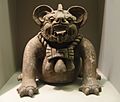Zapotec civilisation facts for kids
The Zapotec civilization was an ancient culture in what is now southern Mexico. They lived mainly in the Oaxaca Valley in a region called Mesoamerica. Experts believe their culture started at least 2,500 years ago.
The Zapotec people left behind amazing clues about their lives in the old city of Monte Albán. Here, you can find buildings, ball courts, impressive tombs, and special items buried with the dead. Beautiful gold jewelry was also found in these tombs.
Monte Albán was a very important city. It was the first major city in the western part of the world. It became the center of a Zapotec state that controlled a large area, much of which is now the state of Oaxaca.
Contents
What Does "Zapotec" Mean?
The name Zapotec comes from the Nahuatl language. The word tzapotēcah means "people from the place of sapote." A sapote is a type of fruit.
The Zapotec people called themselves Be'ena'a. This simply means "The People."
Amazing Zapotec Inventions
The Zapotec people were very smart. They created their own calendar system. They also developed a special way of writing. This writing system had a unique symbol, or glyph, for each sound in their language.
Many believe the Zapotec writing system was one of the first in Mesoamerica. It likely influenced the writing styles of later cultures like the Maya, Mixtec, and Aztec. Some symbols found from the Olmec culture might be even older, but this is still debated by experts.
Zapotec and Mixtec artists were highly skilled. They made beautiful jewelry for the Aztec rulers, called tlatoanis, in the Aztec capital of Tenochtitlan. One famous ruler they made jewelry for was Moctezuma II.
The Zapotec people had connections with other big cities in central Mexico for a long time. For example, archaeologists have found a Zapotec area within the city of Teotihuacán. Also, a guesthouse built in the Teotihuacan style was found in Monte Albán.
Other important Zapotec sites include Lambityeco, Dainzu, Mitla, Yagul, San José Mogote, El Palmillo, and Zaachila.
The Zapotec were a settled culture. This means they lived in one place. They built large villages and towns. Their homes were made of stone and mortar. They kept records of important events using hieroglyphics. In battles, they wore cotton armour to protect themselves. The famous ruins of Mitla are believed to be Zapotec, possibly even tombs for their ancestors.
Zapotec Beliefs and Gods
Like most ancient Mesoamerican cultures, the Zapotec religion had many gods. This is called being polytheistic. Two of their main gods were Cocijo, the rain god, and Coquihani, the god of light. Cocijo was similar to the Aztec god Tlaloc.
It is thought that the Zapotec sometimes used human sacrifice in their religious ceremonies.
The Zapotec people believed their ancestors came from the earth or from caves. Some even thought their ancestors turned from trees or jaguars into humans. The leaders, or elite, believed they came from special beings who lived among the clouds. They thought they would return to the clouds after they died. In fact, the name "Zapotec" comes from this belief. In the Central Valley Zapotec language, "The Cloud People" is "Be'ena' Za'a."
Zapotec Warriors and History
The last big battle between the Aztecs and the Zapotecs happened between 1497 and 1502. This was during the rule of the Aztec leader Ahuitzotl.
When the Spanish arrived in Mexico and defeated the Aztecs, the Zapotec King Cosijoeza told his people not to fight the Spanish. He wanted to avoid the same fate as the Aztecs. However, the Zapotec were still defeated by the Spanish after several battles between 1522 and 1527.
Even after being conquered, the Zapotec people continued to resist. They rebelled against the Spanish rulers in 1550, 1560, and 1715. Later, in 1850, they rebelled against the local government in Oaxaca. In 1866, they fought against the Royal French Army during the French invasion of Mexico. More recently, there was an uprising against a local governor in the late 1970s.
Images for kids
-
Painted ceramic funerary urn depicting a seated figure. Zapotec culture (phase Monte Albán III), Early and Middle Classic Period (100-700 AD). Mexico.
See also
 In Spanish: Cultura zapoteca para niños
In Spanish: Cultura zapoteca para niños







